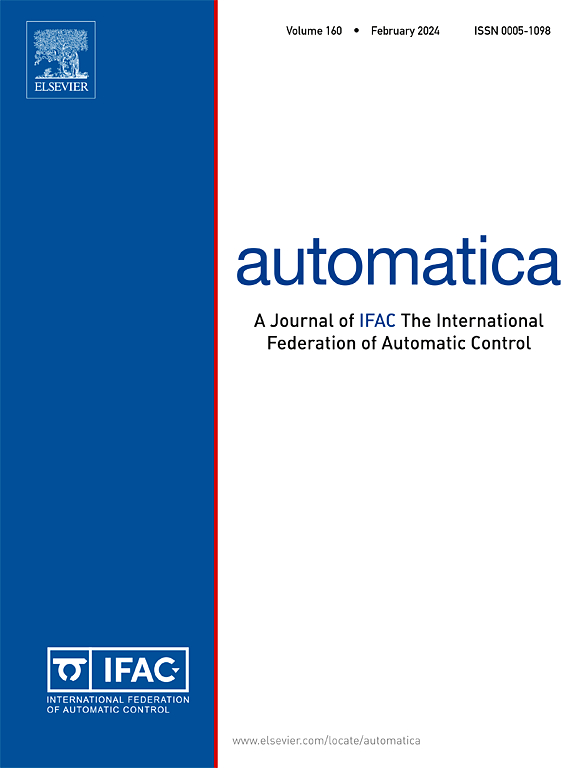不确定Euler-Bernoulli偏微分方程柔性梁系统的事件触发自适应安全导向障碍Lyapunov函数边界控制
IF 5.9
2区 计算机科学
Q1 AUTOMATION & CONTROL SYSTEMS
引用次数: 0
摘要
在事件触发环境下,PDE柔性梁系统的安全边界控制领域既有趣又缺乏探索。如果这样的系统受到潜在冲突的时变硬约束和软约束,以及不确定性和干扰,那么潜在的问题就会变得更加复杂。在本研究中,我们提出了一种解决方案,以解决这一具有技术意义和挑战性的问题。首先,引入动态约束区域,规划方案可调,便于时变约束的建立和规定的软约束恢复;在这个策略中,更高的优先级被赋予硬约束,确保安全需求得到一致的满足,而软约束只有在与硬约束一致时才被适应。其次,我们开发了一个事件触发的自适应安全边界控制器,其中执行器信号和参数估计器在事件驱动的基础上间歇执行,确保控制输入和参数估计都采用分段常数值。因此,可以同时处理未知的阻尼系数(即粘性、结构和Kelvin-Voigt阻尼)、弯曲刚度和边界扰动,同时有效地抑制自适应学习瞬态引起的控制输入中的不希望的振动甚至共振。通过协同设计,我们保证闭环系统的安全性和稳定性,确保触发时刻之间的最小驻留时间,正如李亚普诺夫分析严格验证的那样。最后,通过综合数值模拟验证了该算法的有效性。本文章由计算机程序翻译,如有差异,请以英文原文为准。
Event-triggered adaptive safe-oriented barrier Lyapunov function-based boundary control of flexible beam systems characterized by uncertain Euler–Bernoulli PDEs
The territory of safe boundary control for PDE characterized flexible beam systems in an event-triggering context is both intriguing and under-explored. The underlying problem becomes even more complicated if such systems are subject to potentially conflicting time-varying hard and soft constraints, as well as uncertainties and disturbances. In this study, we present a solution to this technically significant and challenging problem. Firstly, we introduce a dynamic constraint region with an adjustable planning scheme, facilitating the establishment of time-varying constraints and prescribed soft constraint recovery. Within this strategy, higher priority is given to hard constraints, ensuring that safety requirements are consistently met, while soft constraints are accommodated only when they align with the hard constraints. Secondly, we develop an event-triggered adaptive safe boundary controller, where the actuator signal and parameter estimators are executed intermittently on an event-driven basis, ensuring that both the control input and parameter estimates employ piecewise-constant values. Consequently, the unknown damping coefficients (i.e., viscous, structural, and Kelvin–Voigt damping), the bending stiffness, and boundary disturbances are handled simultaneously, while effectively suppressing undesired vibrations or even resonances in the control input posed by the transient of adaptive learning. Through co-design, we guarantee the safety and stability of the closed-loop system, ensuring a minimal dwell-time between triggering instants, as rigorously verified by Lyapunov analysis. Finally, we validate the benefits and efficiency of the proposed algorithm through comprehensive numerical simulations.
求助全文
通过发布文献求助,成功后即可免费获取论文全文。
去求助
来源期刊

Automatica
工程技术-工程:电子与电气
CiteScore
10.70
自引率
7.80%
发文量
617
审稿时长
5 months
期刊介绍:
Automatica is a leading archival publication in the field of systems and control. The field encompasses today a broad set of areas and topics, and is thriving not only within itself but also in terms of its impact on other fields, such as communications, computers, biology, energy and economics. Since its inception in 1963, Automatica has kept abreast with the evolution of the field over the years, and has emerged as a leading publication driving the trends in the field.
After being founded in 1963, Automatica became a journal of the International Federation of Automatic Control (IFAC) in 1969. It features a characteristic blend of theoretical and applied papers of archival, lasting value, reporting cutting edge research results by authors across the globe. It features articles in distinct categories, including regular, brief and survey papers, technical communiqués, correspondence items, as well as reviews on published books of interest to the readership. It occasionally publishes special issues on emerging new topics or established mature topics of interest to a broad audience.
Automatica solicits original high-quality contributions in all the categories listed above, and in all areas of systems and control interpreted in a broad sense and evolving constantly. They may be submitted directly to a subject editor or to the Editor-in-Chief if not sure about the subject area. Editorial procedures in place assure careful, fair, and prompt handling of all submitted articles. Accepted papers appear in the journal in the shortest time feasible given production time constraints.
 求助内容:
求助内容: 应助结果提醒方式:
应助结果提醒方式:


